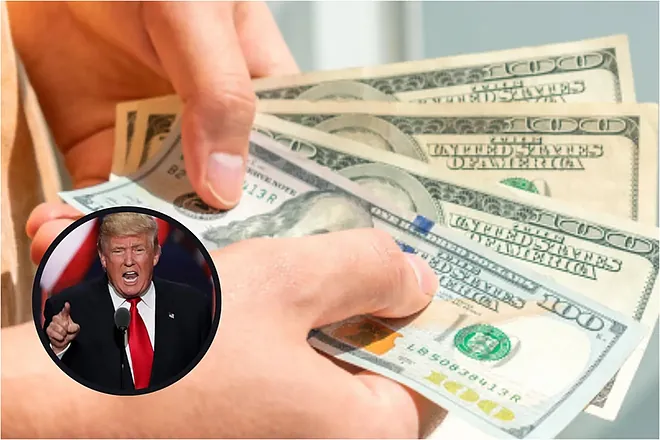The discussion around Tariff Rebate Checks has surged in 2025, as families across the United States await potential relief from higher tariffs. Spearheaded by Republican Senator Josh Hawley and backed by former President Donald Trump, this initiative—officially called the American Worker Rebate Act—aims to return a portion of tariff revenues directly to households.
In this article, we break down everything you need to know: who qualifies, how much a family of four could receive, the timeline for disbursement, and key criticisms of the plan.

What Are Tariff Rebate Checks?
Tariff Rebate Checks are a proposed form of direct government payments to American households, modeled after pandemic-era stimulus checks. Unlike traditional tax refunds, these rebates are funded specifically by revenue generated from tariffs imposed on imports.
The goal is twofold:
- Relieve financial pressure on consumers affected by higher prices due to tariffs.
- Stimulate economic activity by putting cash directly into the hands of families.
According to supporters, including President Trump, the initiative could act as a “dividend for Americans” who have already paid substantial taxes and faced increasing costs from tariffs.
How the American Worker Rebate Act Works
The American Worker Rebate Act lays out a clear framework for distributing Tariff Rebate Checks:
- Rebate Amounts
- $600 per person: Each adult and child in the household qualifies for a $600 payment.
- Example: A family of four would receive $2,400 ($600 x 4).
- Income-Based Adjustments
- Individuals earning over $75,000, heads of households over $112,500, and married couples over $150,000 receive reduced payments.
- Payments are gradually phased out above these thresholds.
- Funding Source
- Revenue comes from tariffs imposed on imported goods.
- The Congressional Budget Office estimates that tariffs could reduce the federal deficit by $4 trillion over a decade, although critics argue that families could pay up to $2,500 more per year due to these tariffs.
Eligibility Criteria for Tariff Rebate Checks
Eligibility is based on household income and tax filings for 2025. Here’s a quick summary:
| Household Type | Income Threshold | Full Payment Eligibility |
|---|---|---|
| Single filer | $75,000 | Yes |
| Head of Household | $112,500 | Yes |
| Married filing jointly | $150,000 | Yes |
| Above thresholds | N/A | Reduced or phased-out payment |
These limits ensure that Tariff Rebate Checks are targeted at middle- and lower-income families, who are more affected by rising prices due to tariffs.
How Much Could a Family of Four Receive?
One of the most pressing questions is: how much would a typical family get?
- Two working adults + two children: $600 per person = $2,400 total
- Example for higher-income families: A married couple earning $160,000 with two children would receive a reduced payment, as the phase-out formula applies.
This payout structure mirrors pandemic stimulus checks but is directly tied to tariff revenue, rather than general government funds.
Timeline for Distribution
The proposed mechanism for distributing Tariff Rebate Checks is through refundable tax credits on 2025 tax filings. Here’s what the timeline could look like:
- Legislative approval: Pending congressional vote in late 2025.
- Distribution: Likely late 2025 or early 2026, depending on processing and IRS systems.
- Method: Direct deposit or mailed checks, similar to previous stimulus payments.
Supporters of Tariff Rebate Checks
The initiative has notable political backing:
- President Donald Trump: Advocates using tariff revenues to provide a “dividend” to Americans.
- Senator Josh Hawley: Introduced the American Worker Rebate Act to Congress.
Supporters argue that Tariff Rebate Checks:
- Help families offset the rising costs of goods.
- Boost consumer spending, which can stimulate economic growth.
- Provide immediate financial relief to millions of households.
Criticisms and Concerns
While the idea is appealing, Tariff Rebate Checks face several criticisms:
- Inflation risk: Opponents warn that distributing additional cash could exacerbate inflation.
- Impact on federal debt: While tariffs generate revenue, some lawmakers prefer using those funds to reduce national debt.
- Unequal effect: Families who earn just above the thresholds may feel unfairly excluded from full benefits.
Economists remain divided on whether tariff-funded rebates are an effective long-term solution for economic growth.
Comparing Tariff Rebate Checks to Previous Stimulus Payments
| Feature | Pandemic Stimulus Checks | Tariff Rebate Checks |
|---|---|---|
| Funding Source | General government funds | Tariff revenue |
| Per-Person Payment | $600–$1,400 | $600 |
| Eligibility | Income-based | Income-based (phased out at higher incomes) |
| Purpose | Economic relief during pandemic | Offset cost of tariffs & stimulate economy |
| Distribution | Tax credits / direct deposit | Tax credits / direct deposit |
This comparison highlights that while the structure is familiar, the funding source and economic rationale are unique.
Economic Implications of Tariff Rebate Checks
The potential benefits and drawbacks can be summarized as follows:
- Pros:
- Direct financial relief for households.
- Incentive for consumer spending.
- Political appeal for middle-income voters.
- Cons:
- Could contribute to inflationary pressures.
- May not fully offset increased costs from tariffs.
- Could face delays depending on congressional approval and IRS processing.
By linking rebate amounts directly to tariffs, the policy attempts to target the specific economic burden rather than providing blanket relief.
How Families Can Prepare
If approved, families should consider:
- Updating tax information: Ensure IRS records are current for direct deposit.
- Estimating eligibility: Use 2025 income projections to calculate potential rebates.
- Budgeting for changes: Plan for additional funds in late 2025 or early 2026.
This proactive approach ensures that households can maximize the benefit from Tariff Rebate Checks.
Statements from Key Figures
Donald Trump highlighted the rationale:
“We have a lot of money coming in. It’s coming in in enormous numbers. There’s a concept of giving a dividend to the people of this country who have paid a lot of taxes and haven’t received anything in return.”
Senator Josh Hawley emphasized the need to support American families:
“Tariff revenues have grown, and it’s only fair that working Americans see some of that money returned directly to them.”
These statements underscore the political and social appeal of Tariff Rebate Checks.
Frequently Asked Questions (FAQ)
Q1: Who qualifies for the full rebate?
A: Individuals earning under $75,000, heads of household under $112,500, and married couples under $150,000.
Q2: How much does a family of four receive?
A: $2,400, assuming they are under the income thresholds.
Q3: When will payments be distributed?
A: Likely late 2025 or early 2026, pending congressional approval.
Q4: How are payments issued?
A: Through refundable tax credits, either via direct deposit or mailed checks.
Q5: Are there risks associated with these rebates?
A: Yes—potential inflation and political debate over national debt allocation.
Tariff Rebate Checks at a Glance
| Feature | Details |
|---|---|
| Payment Amount | $600 per person; $2,400 for a family of four |
| Eligibility | Based on 2025 income; phased out above thresholds |
| Distribution Method | Refundable tax credit (tax return) |
| Timing | Late 2025 / early 2026 |
| Legislative Status | Introduced; awaiting congressional approval |
| Supporters | President Trump, Senator Josh Hawley |
| Criticism | Inflation risk, potential inequity, national debt concerns |
The debate over Tariff Rebate Checks is shaping up to be a major economic story in 2025. For families of four, the potential $2,400 payout represents significant relief, especially in the face of rising costs due to tariffs. While critics warn of inflation and fiscal impact, supporters argue this is a fair and direct way to return tariff revenues to working Americans.
Households should monitor the progress of the American Worker Rebate Act, update their tax information, and prepare for possible disbursement late in the year.
By understanding the eligibility rules, income thresholds, and distribution timelines, families can ensure they receive the maximum benefit from this proposed stimulus.







